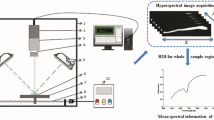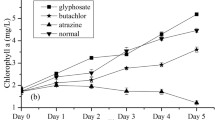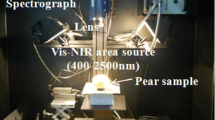Abstract
Flos Lonicerae is often sulfur-fumigated during post-harvest handling, but excessive sulfur fumigation can reduce the quality of Flos Lonicerae products and then is harmful to human health. In order to achieve rapid and non-destructive identification for sulfur fumigated Flos Lonicerae, hyperspectral imaging was explored to establish detection models for sulfur fumigated Flos Lonicerae. A total of 450 Flos Lonicerae samples with different sulfur fumigation degrees were collected by a hyperspectral imaging system (371–1024 nm). Principle component analysis was applied to explore the separability of different sulfur fumigated Flos Lonicerae samples, and preliminary results demonstrated that sulfur fumigated Flos Lonicerae samples showed a trend of classification. Then, a method for data pretreatment, Savitzky–Golay filter (SG) combined with the standard normalized variable (SNV), was applied for de-noising and smoothing of the original data. The competitive adaptive reweighted sampling (CARS) algorithm was used to extract the optimal wavelengths ranged from 421 to 917 nm, and simultaneously the effect of CARS algorithm was compared with that of the successive projection algorithm and regression coefficient algorithm to determine the best method for the selection of optimal wavelengths. Least squares support vector machine (LS-SVM) and partial least squares regression (PLSR) were applied to build the classification models based on full spectra preprocessed by SG–SNV method. In order to simplify the calibration model, the PLSR, LS-SVM and BP neural network algorithms were used to build models based on optimal wavelengths. The overall results revealed that all models could achieve fast and non-destructive identification of sulfur fumigated Flos Lonicerae. The model based on CARS obtained optimal performance, and the CARS–LS-SVM model had the best classification effect for the prediction set with the correlation coefficient \(R_{P}^{2}\) of 0.9109 and the root mean square error of 0.3353. Therefore, hyperspectral imaging technology combined with chemometrics can be utilized to achieve fast and non-destructive inspection for Flos Lonicerae fumigated with different sulfur concentrations.







Similar content being viewed by others
References
D.X. Kong, Y.Q. Lia, M. Bai, H.J. He, G.X. Liang, H. Wu, Correlation between the dynamic accumulation of the main effective components and their associated regulatory enzyme activities at different growth stages in Lonicera japonica Thunb. Ind. Crop. Prod. 96, 16–22 (2017)
X. Shang, H. Pan, M. Li, X. Miao, H. Ding, Lonicera japonica Thunb.: ethnopharmacology, phytochemistry and pharmacology of an important traditional Chinese medicine. J. Ethnopharmacol. 138(1), 1–21 (2011)
X. Yang, Y. Liu, A. Hou, Y. Yang, X. Tian, L. He, Systematic review for geo-authentic Lonicerae Japonicae Flos. Front. Med. 11(2), 203–213 (2017)
Y.H. Liu, S. Miao, J.Y. Wu, J.X. Liu, H.C. Yu, X. Duan, Drying characteristics and modeling of vacuum far-infrared radiation drying of Flos Lonicerae. J. Food Process. Pres. 39(4), 338–348 (2015)
A.L. Guo, L.M. Chen, Y.M. Wang, X.Q. Liu, Q.W. Zhang, Influence of sulfur fumigation on the chemical constituents and antioxidant activity of buds of Lonicera japonica. Molecules 19(10), 16640–16655 (2014)
X.Y. Li, F. Long, J.D. Xu, H. Shen, M. Kong, H. Zhu, Paeonifiorin sulfonate as a characteristic marker for specifically inspecting Chinese patent medicine Liu-Wei-Di-Huang-Wan contained sulfur-fumigated Moutan Cortex. J. Pharm. Biomed. Anal. 138, 283–288 (2017)
C.Y. Wu, M. Kong, W. Zhang, F. Long, J. Zhou, S.S. Zhou, Impact of sulphur fumigation on the chemistry of ginger. Food Chem. 239, 953–963 (2017)
Committee for the Pharmacopoeia of PR China, Pharmacopoeia of the PR China (China Medical Science and Technology Press, Beijing, 2015)
S.L. Li, H. Shen, L.Y. Zhu, J. Xu, X.B. Jia, H.M. Zhang, Ultra-high-performance liquid chromatography—quadrupole/time of flight mass spectrometry based chemical profiling approach to rapidly reveal chemical transformation of sulfur—fumigated medicinal herbs, a case study on white ginseng. J. Chromatogr. A. 1231, 31–45 (2012)
N. Hu, J. Da, X. Chen, S.R. Li, Q.R. Wang, T.T. Wu, A precise and specific method for quick determination of sulfur fumigation for moutan cortex. World J. Tradit. West Chin. Med. 3(1), 16–21 (2017)
X.Y. Wu, Z.M. Chao, W. Sun, C. Wang, Qualitative and quantitative research on sulfur fumigation of Angelicae Dahuricae Radix (Baizhi) by near-infrared spectroscopy. China J. Chin. Mater. Med. 39(10), 1863–1868 (2014)
D. Wu, H. Shi, S. Wang, Y. He, Y. Bao, K. Liu, Rapid prediction of moisture content of dehydrated prawns using online hyperspectral imaging system. Anal. Chim. Acta 726(9), 57–66 (2012)
Y. Lu, Y. Huang, R. Lu, Innovative Hyperspectral imaging-based techniques for quality evaluation of fruits and vegetables: a review. Appl. Sci. 7(2), 1–36 (2017)
C. Zhang, H. Jiang, F. Liu, Y. He, Application of near-infrared hyperspectral imaging with variable selection methods to determine and visualize caffeine content of coffee beans. Food Bioprocess. Technol. 10(1), 1–9 (2017)
C. Zhang, Q. Wang, F. Liu, Y. He, Y. Miao, Rapid and non-destructive measurement of spinach pigments content during storage using hyperspectral imaging with chemometrics. Measurement 97, 149–155 (2016)
J.B. Li, X.Q. Rao, Y.B. Ying, Dection of common defects on oranges using hyperspectral reflectance imaging. Comput. Electron. Agric. 78(1), 38–48 (2011)
T. Mohammadi-Moghaddam, S.M.A. Razavi, M. Taghizadeh, B. Pradhan, A. Sazgarnia, Hyperspectral imaging as an effective tool for prediction the moisture content and textural characteristics of roasted pistachio kernels. J. Food Meas. Charact. 2018, 1–10 (2018)
J.H. Cheng, D.W. Sun, Hyperspectral imaging as an effective tool for quality analysis and control of fish and other seafoods: Current research and potential applications. Trends Food Sci. Technol. 37(2), 78–91 (2014)
Y.H. Liu, Y. Sun, A.G. Xie, H.C. Yu, Y. Yin, X. Li, X. Duan, Potential of hyperspectral imaging for rapid prediction of anthocyanin content of purple-fleshed sweet potato slices during drying process. Food Anal. Methods 10(12), 3836–3846 (2017)
C. Mo, M.S. Kim, G. Kim, J. Lim, S.R. Delwiche, K. Chao, Spatial assessment of soluble solid contents on apple slices using hyperspectral imaging. Biosyst. Eng. 159, 10–21 (2017)
Q. Liu, K. Sun, J. Peng, M. Xing, L. Pan, K. Tu, Identification of bruise and fungi contamination in strawberries using hyperspectral imaging technology and multivariate analysis. Food Anal. Methods 11(5), 1518–1527 (2018)
K. Mollazade, Non-destructive Identifying level of browning development in button mushroom (Agaricus bisporus) using hyperspectral imaging associated with chemometrics. Food Anal. Methods 10(8), 1–12 (2017)
H. Zhang, T. Wu, L.F. Zhang, P. Zhang, Development of a portable field imaging spectrometer: application for the identification of sun-dried and sulfur-fumigated Chinese herbals. Appl. Spectrosc. 70(5), 879–887 (2016)
J. He, C. Zhang, Y. He, Application of near-infrared hyperspectral imaging to detect sulfur dioxide residual in the Fritillaria thunbergii Bulbus treated by sulfur fumigation. Appl. Sci. 7(1), 1–11 (2017)
H. Cen, R. Lu, Q. Zhu, F. Mendoza, Nondestructive detection of chilling injury in cucumber fruit using hyperspectral imaging with feature selection and supervised classification. Postharvest Biol. Technol. 111, 352–361 (2016)
B. Li, M. Cobo-Medina, J. Lecourt, N.B. Harrison, R.J. Harrison, J.V. Cross, Application of hyperspectral imaging for nondestructive measurement of plum quality attributes. Postharvest Biol. Technol. 141, 8–15 (2018)
M. Nocita, A. Stevens, G. Toth, P. Panagos, B.V. Wesemael, L. Montanarella, Prediction of soil organic carbon content by diffuse reflectance spectroscopy using a local partial least square regression approach. Soil Biol. Biochem. 68(1), 337–347 (2014)
J.H. Cheng, D.W. Sun, Partial least squares regression (PLSR) applied to NIR and HSI spectral data modeling to predict chemical properties of fish muscle. Food Eng. Rev. 9(1), 36–49 (2017)
Y. Seo, B. Park, A.H. Jr, S.C. Yoon, K.C. Lawrence, Identification of staphylococcus species with hyperspectral microscope imaging and classification algorithms. J. Food Meas. Charact. 10(2), 253–263 (2016)
T. Sun, W.L. Xu, T. Hu, M.H. Liu, Application of LS-SVM and variable selection methods on predicting SSC of nanfeng mandarin fruit. Comput. Comput. Technol. Agric. 419, 249–262 (2013)
Q. Yang, D.W. Sun, W. Cheng, Development of simplified models for nondestructive hyperspectral imaging monitoring of TVB-N contents in cured meat during drying process. J. Food Eng. 192, 53–60 (2017)
J. Dong, W. Guo, Nondestructive determination of apple internal qualities using near-infrared hyperspectral reflectance imaging. Food Anal. Methods 8(10), 2635–2646 (2015)
N.N. Wang, Y.C. Yang, D.W. Sun, H. Pu, Z. Zhu, Shelf-Life prediction of ‘Gros Michel’ bananas with different browning levels using hyperspectral reflectance imaging. Food Anal. Methods 8(5), 1173–1184 (2015)
H. Zhu, B. Chu, C. Zhang, F. Liu, L. Jiang, Y. He, Hyperspectral imaging for presymptomatic detection of tobacco disease with successive projections algorithm and machine-learning classifiers. Sci. Rep. 7(1), 1–12 (2017)
L. Nie, Z. Dai, S. Ma, Enhanced accuracy of near-infrared spectroscopy for traditional chinese Medicine with competitive adaptive reweighted sampling. Anal. Lett. 49(14), 2259–2267 (2016)
W. Chen, J. Zou, F. Wan, Z. Fan, D. Yang, Application of surface enhanced Raman scattering and competitive adaptive reweighted sampling on detecting furfural dissolved in transformer oil. AIP Adv. 8(3), 1–11 (2018)
T. Mizutani, M. Tanaka, Efficient preconditioning for noisy separable nonnegative matrix factorization problems by successive projection based low-rank approximations. Mach. Learn. 107(4), 643–673 (2018)
Z. Xiong, D.W. Sun, A. Xie, H. Pu, Z. Fan, Quantitative determination of total pigments in red meats using hyperspectral imaging and multivariate analysis. Food Chem. 178, 339–345 (2015)
Y.C. Yang, D.W. Sun, N.N. Wang, Rapid detection of browning levels of lychee pericarp as affected by moisture contents using hyperspectral imaging. Comput. Electron. Agric. 113, 203–212 (2015)
S. Fan, W. Huang, Z. Guo, B. Zhang, C. Zhao, Prediction of soluble solids content and firmness of pears using hyperspectral reflectance imaging. Food Anal. Methods 8(8), 1936–1946 (2015)
W. Che, L. Sun, Q. Zhang, W. Tan, D. Ye, D. Zhang, Pixel based bruise region extraction of apple using Vis-NIR hyperspectral imaging. Comput. Electron. Agr. 146, 12–21 (2018)
Y. Bi, K. Yuan, W. Xiao, J. Wu, C. Shi, J. Xia, A local pre-processing method for near-infrared spectra, combined with spectral segmentation and standard normal variate transformation. Anal. Chim. Acta 909, 30–40 (2016)
Acknowledgements
The authors express their sincere appreciation to the National Natural Science Foundation of China (project U1404334), the Science and Technology Project of Henan Province (project 172102310617 and project 172102210256) and the Natural Science Foundation of Henan Province (project 162300410100) for supporting this study financially.
Author information
Authors and Affiliations
Corresponding author
Rights and permissions
About this article
Cite this article
Liu, Y., Wang, Q., Xu, Q. et al. Non-destructive detection of Flos Lonicerae treated by sulfur fumigation based on hyperspectral imaging. Food Measure 12, 2809–2818 (2018). https://doi.org/10.1007/s11694-018-9896-z
Received:
Accepted:
Published:
Issue Date:
DOI: https://doi.org/10.1007/s11694-018-9896-z




